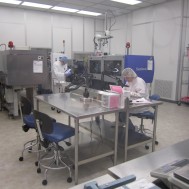Ever wonder just how clean our clean room actually is?
It’s a fair question — and one we ask ourselves on a regular basis. We sample the clean room air multiple times each week to ensure the atmosphere in which the medical rubber parts are processed is appropriate.
The clean room is classified as a Class 10,000 (ISO Class 7) clean room environment. This means that there are a maximum of 10,000 particles larger than 0.5 microns per cubic foot in the clean room itself. In fact, because of our own strict standards, the Apple Rubber clean room is certified by an outside auditor as a Class 10,000 (ISO Class 7) work space, but most of the time achieves Class 1,000 (ISO Class 6).
So we’ve established that the room itself is clean — as clean, or cleaner, in many cases, than a hospital’s operating room. Confident in our cleanliness, liquid silicone rubber is pumped into the press located inside the clean room, the material is molded into the appropriate shapes and sizes, inspected, and post-cured.
The final step in the production process for our clean room O-rings is a trip through the automated ultrasonic cleaning system. This journey entails six stages: 1.) loading the O-rings into stainless steel wire mesh baskets, 2.) submersion in the ultrasonic cascade overflow wash tank at 140 degrees Fahrenheit for six minutes in purified water and 1% valtron SP220 detergent, 3.) submersion in the ultrasonic cascade overflow rinse tank for six minutes, 4.) a second six-minute rinsing session, 5.) 15 minutes of hot air drying at 225 degrees Fahrenheit, and 6.) unloading for packaging.
Ironically enough, the act of cleaning could potentially contaminate our finished O-rings with pyrogens (bacterial endotoxins) if the water used is not properly treated. In 2013, Apple Rubber made a substantial investment in a sophisticated water treatment system to ensure that our clean room products remain non-pyrogenic when they are washed.
“Most everything that is cleaned in our clean room is a medical part, for medical devices like dialysis pumps, spinal implants, things like that,” explained Project Engineer Dave Meehan on a recent tour of the clean room area. “If pyrogens get injected into your body through one of those types of devices, it can make you suffer from a fever. If someone finds themselves in need of a medical device they are generally in some state of poor health. The last thing we want to do is make them even sicker. We need to hold these devices to a higher standard.”
The process water starts out as the same liquid you would draw from a tap. This water is then significantly purified using a series of particulate, ultraviolet (UV), reverse osmosis, deionization and sub-micron filters. The water is then subjected to continuous testing for electrical resistivity (pure water does not carry electrical currents as easily as untreated water) and total organic carbon (TOC). If the results do not meet specifications, the cleaning process is automatically halted and alarms are sounded.
As it is purified, the water is pumped through a circulating loop to ensure its quality.
“If you have standing water, it can grow bacteria,” Meehan said. “The water is constantly flowing. We have clean raw material coming in from the supplier, and we don’t want to contaminate it in any way.”
That’s a fairly elaborate process to ensure that our clean room water is pure — but well worth the investment to the thousands of patients around the world whose sensitive medical procedures put them in contact with our O-rings.
“It should be cleaner than what someone would actually need,” Meehan said. “We’re trying to go for the cleanest part that could be required.”
The clean room is in use for approximately 100 hours per week, Monday through Friday, with weekend shifts added on an as-needed basis.
